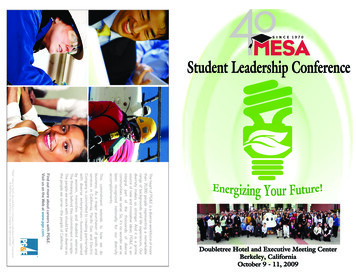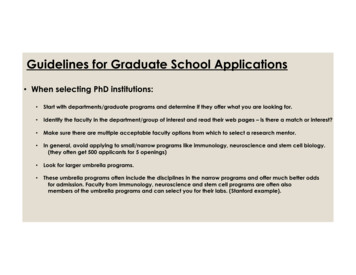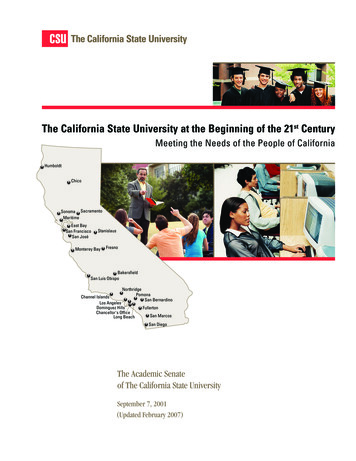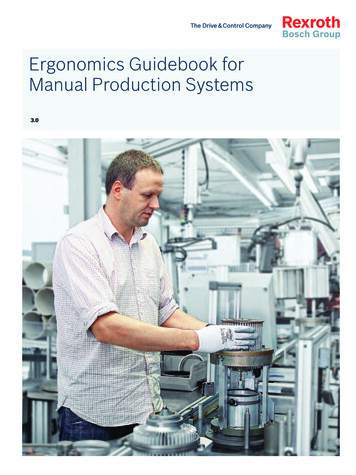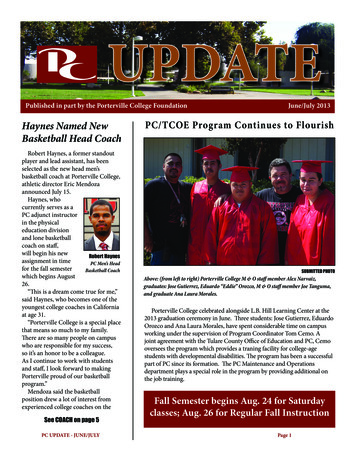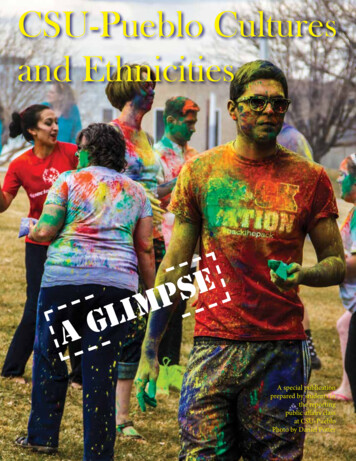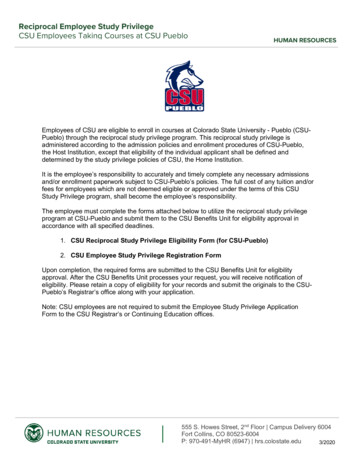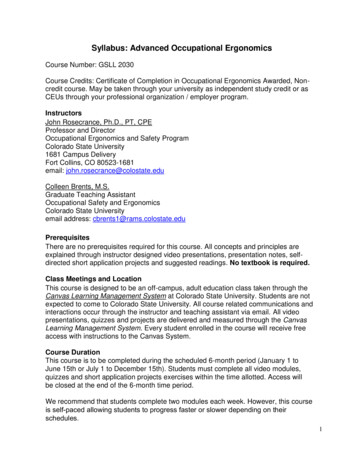
Transcription
Syllabus: Advanced Occupational ErgonomicsCourse Number: GSLL 2030Course Credits: Certificate of Completion in Occupational Ergonomics Awarded, Noncredit course. May be taken through your university as independent study credit or asCEUs through your professional organization / employer program.InstructorsJohn Rosecrance, Ph.D., PT, CPEProfessor and DirectorOccupational Ergonomics and Safety ProgramColorado State University1681 Campus DeliveryFort Collins, CO 80523-1681email: john.rosecrance@colostate.eduColleen Brents, M.S.Graduate Teaching AssistantOccupational Safety and ErgonomicsColorado State Universityemail address: cbrents1@rams.colostate.eduPrerequisitesThere are no prerequisites required for this course. All concepts and principles areexplained through instructor designed video presentations, presentation notes, selfdirected short application projects and suggested readings. No textbook is required.Class Meetings and LocationThis course is designed to be an off-campus, adult education class taken through theCanvas Learning Management System at Colorado State University. Students are notexpected to come to Colorado State University. All course related communications andinteractions occur through the instructor and teaching assistant via email. All videopresentations, quizzes and projects are delivered and measured through the CanvasLearning Management System. Every student enrolled in the course will receive freeaccess with instructions to the Canvas System.Course DurationThis course is to be completed during the scheduled 6-month period (January 1 toJune 15th or July 1 to December 15th). Students must complete all video modules,quizzes and short application projects exercises within the time allotted. Access willbe closed at the end of the 6-month time period.We recommend that students complete two modules each week. However, this courseis self-paced allowing students to progress faster or slower depending on theirschedules.1
MaterialsAll course materials (video presentations, PowerPoint presentation notes, quizzes,application projects and selected readings) are provided through the Canvas LearningSystem. The course is divided into 26 video presentation modules covering the broadtopics related to Occupational Ergonomics. Each video presentation is approximately 30to 40 minutes in length. Each video presentation has PowerPoint presentation notes (inPDF) that follow along with the topics discussed. Some modules have suggestedreadings for additional information on that topic. At the end of each video module is a 15item quiz to test your knowledge of the material covered.The Certificate of Completion in Occupational ErgonomicsAt the successful completion of this online course, the student will receive a signedCertificate of Completion in Advanced Occupational Ergonomics from Colorado StateUniversity. Successful completion is defined as a score of 80% on the total points of thequizzes and short application projects.Although this course is designed to address components of the core competenciesoutlined by the Board of Certification in Professional Ergonomics (BCPE)http://www.bcpe.org/ , this course does not directly lead to certification in professionalergonomics from the BCPE. This course is designed to provide additional content in twoof the four broad core competencies, specifically the BCPE competencies in ErgonomicAnalysis and Ergonomic Design (see .Course ContentThe online Advanced Occupational Ergonomics course focuses on the human-workinteraction. The curriculum provides beginning through advanced level knowledge, skillsand competencies in occupational ergonomics (see Course Units and Modules below).This comprehensive course is appropriate for individuals with no experience inergonomics and those looking for more advanced training and skills. Individualscompleting the course will be able to apply concepts and principles of ergonomics toidentify, develop, implement and evaluate design solutions to ergonomic challenges inthe work environment.Course Focus and ObjectivesThe course content is focused around four general goals of occupational ergonomicsincluding: 1) improved work efficiency and productivity,2) enhanced quality of products and or services,3) reduced injuries and illnesses, and4) enhanced quality of work life.2
Course Objectives - At the completion of the course the student participantwill be able to: Outline the historical contributions related to modern work processes. Prepare for an on-site ergonomics risk assessment of specific job tasks. Discuss how workstation organization and layout, equipment, and work processesinfluence the risk of musculoskeletal disorders and how to prevent them throughergonomics design. Analyze workplace design using the principles of anthropometry, occupationalbiomechanics, work physiology and epidemiology. Apply anthropometry tables for evaluation and design criteria. Identify engineering solutions to improve production efficiency and reduce the riskof musculoskeletal disorders. Analyze ergonomics design principles for manual materials handling tasks. Apply the NIOSH Lifting Equation for manual material handling tasks and developinterventions based on the Lifting Equation parameters. Identify the changing needs of the existing and future workforce. Apply the use of ergonomic risk assessment tools including: Rapid Entire BodyAssessment (REBA), Rapid Upper Limb Assessment (RULA), Rodgers MuscleFatigue Analysis, Hand Activity Level (HAL) and the Revised Strain Index. Identify the association or causation between occupational and non-occupationalrisk factors and musculoskeletal disorders. Apply ergonomic principles to office workstations and design the office layout toreduce the negative health effects of prolonged sitting. Apply the use of the OSHA computer workstation evaluation in an officeenvironment. Discuss how telepressure, shift work and sleep issues affect and influence jobperformance as they relate to absenteeism and presenteeism. Define work stress and solutions to reduce related adverse health outcomes. Diagram the essential elements of an ergonomic process. Conduct the 5-step ergonomics problem solving process to develop successfulsolutions specific to the needs of the workplace environment. Conduct cost-benefit analyses and return on investment (ROI) calculations to justifyproposed ergonomic solutions. Understand the certification process for professional ergonomists as outlined by theBoard of Certification in Professional Ergonomists. Demonstrate competency through the successful completion of three applied workprojects and 390 exam (quiz) questions.3
Module Learning ObjectivesEach video module (and accompanying presentation notes) begins with a set of specificlearning objectives for the topic(s) covered.Methods of Performance EvaluationEach video presentation is followed by a quiz that must be completed. Additionally, thereare six short application projects to complete within selected modules.There are 15 questions per quiz (15 points total). Students have 2-hours to complete thequiz. Short application projects are worth 30 points each. You are required to complete atleast three of the six application projects. You can choose which three to complete. If youchoose to complete more than three projects, the points will be added to your total as extracredit.Student participants are evaluated based on the quizzes and projects completed. Thereare 26 modules, each with a 15-question quiz.Possible quiz points 390.Possible application project points 90.Course exit survey points 10.Total points (excluding extra credit) 490Letter GradingA 90% (441 points) and completion of at least three application projectsB 80% (392-440 points) and completion of at least three application projectsC 70% (343-391 points) and completion of at least three application projectsPass / Fail Grading – Pass 80% ( 392 points) and completion of at least threeapplication projectsEach student participant that completes the course with a passing grade will receivea Certificate of Completion in Advanced Occupational Ergonomics from ColoradoState UniversityAccommodationsStudents with special needs or limitations will be accommodated by the University to thebest of our ability given the resources available. Please notify the instructor of anyspecial needs that you have relative to this course.If your employer or academic institution needs a transcript or letter of verification ofcompletion in addition to a copy of your certificate, please contact Professor Rosecrance.A letter will be provided at no charge but early planning is appreciated.4
Outline of Course Units and ModulesUNIT A: Introduction to ErgonomicsModule #12TitleIntroduction to the Course and Instructor(s)Introduction to Occupational ErgonomicsUNIT B: Principles of Occupational Ergonomics345*6*7History and Contributors to Current Work PracticesBasics of AnthropometricsApplication of AnthropometricsWork PhysiologyOccupational Biomechanics89Epidemiology and Research Design in ErgonomicsErgonomic Exposure Assessment PrinciplesUNIT C: Musculoskeletal Disorders and Risk Assessment101112*131415*Upper Extremity Anatomy and Musculoskeletal DisordersUpper Extremity Disorders and Associated Risk FactorsUpper Extremity Risk Assessment ToolsBack Anatomy and StructureBack Disorders and Risk FactorsLow Back Risk Assessment: The NIOSH Lifting EquationUNIT D: Physical Human-Work Interface16*17181920Ergonomic Design of Computer WorkstationsDesign and Layout for Productive and Healthy Office WorkOrganization and Layout of Manufacturing WorkstationsWhole Body Risk Assessment ToolsDirect Ergonomic Exposure Assessment ToolsUNIT E: Organizational and Systems Approach2122232425*26Organizational Aspects of the Human-Work Interface to Enhance Safety:Introduction to SafetyDesigning Work with Systematic Procedures to Enhance SafetyOccupational Health Psychology and Perspectives on Work StressAbsenteeism, Presenteeism, Sleep and the WorkplaceSafety and Ergonomics Culture in the WorkplaceErgonomic Programs and Processes* Indicates that module has an application project.5
Syllabus: Advanced Occupational Ergonomics Course Number: GSLL 2030 . Course Credits: Certificate of Completion in Occupational Ergonomics Awarded, Non-credit course. May be taken through your university as independent study credit or as CEUs through your professional organization / employer program. Instructors . John Rosecrance, Ph.D., PT, CPE



